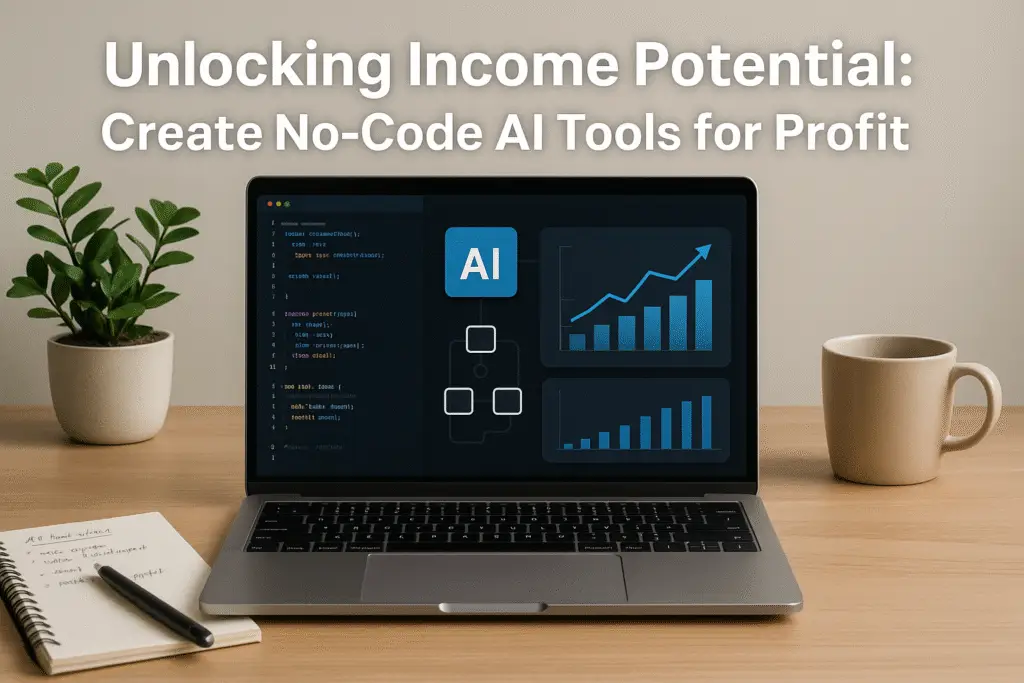Introduction: Unlocking the Power of No Code AI Tools
In today’s fast-paced digital landscape, the emergence of no-code AI tools presents an unprecedented opportunity for generating revenue. No-code AI tools eliminate traditional coding barriers, allowing individuals to innovate and create products that can be monetized with relative ease. This section will guide you through the transformative potential of these tools, emphasizing the steps you can take to build sustainable income streams by harnessing their power.
To begin, it’s vital to understand that the landscape of AI tools is rapidly evolving. As noted in the video, the AI tools market is projected to reach an astounding $400 billion this year, with a strong trajectory towards becoming a trillion-dollar industry in just a few years. This significant growth presents an urgent call to action: if you want to capture a part of this burgeoning market, now is the time to start.
The ease of access to no-code platforms means that you don’t need to be an expert coder to develop functional, market-ready products. By utilizing platforms like the Gemini API, you can create a variety of valuable tools, such as content generation plugins or calculators, within a matter of hours. During the video presentation, practical demonstrations showcased how to build these tools step-by-step, demonstrating their potential to generate wealth simply by following a structured approach and implementing the right strategies.
Here’s the original video for reference:
Understanding the Landscape of Online Money-Making Opportunities
Exploring the myriad online business possibilities in today’s digital landscape requires understanding the latest advancements in technology, particularly in areas like artificial intelligence (AI) and no-code solutions. With over 25 years in the SEO and software industries, I’ve witnessed significant transformations in how businesses operate online. The growing accessibility of AI tools is a pivotal development that opens numerous pathways to profitability, allowing even those without programming skills to participate.
One of the most exciting opportunities currently available is the ability to create no-code AI tools that can generate revenue. These tools can range from simple applications that assist with task automation to complex systems that help manage entire businesses. For instance, using APIs like Google’s Gemini, individuals can speed up the development process, creating specialized tools like content generators and calculators. Consider the growing AI tools market—which is projected to be worth $400 billion this year. This staggering growth stems from the increasing need for specialized AI solutions that cater to diverse business requirements.
The Game-Changer: Using APIs to Create Custom AI Tools
APIs, or Application Programming Interfaces, serve as the backbone for creating powerful custom AI tools, and understanding their functionality is crucial for modern developers and entrepreneurs. At the center of these discussions is the Gemini API, which offers user-friendly capabilities for integrating AI into various applications.
An API essentially allows different applications to communicate with one another. It acts as an intermediary, transferring requests and data from one software to another and then sending back the response. For example, if you want to generate ad copy, your application sends a request to the Gemini API, which processes this request based on pre-defined rules and returns the generated content.
Step-by-Step Guide: Building Your First No Code AI Tool
Creating your first no-code AI tool can be an exciting venture, and this section will walk you through the step-by-step process of bringing your own AI-driven software to life without needing extensive coding skills. We’ll leverage Google’s Gemini API, which simplifies the integration of AI capabilities into your projects.
Step 1: Identify Your Tool Idea
First, think about a specific problem you can solve or an opportunity you can capitalize on. Some examples include:
- A car price calculator that provides users with information on car valuations.
- A real estate flyer generator tailored for realtors to create eye-catching promotional materials.
It’s essential to conduct some preliminary research to validate demand for your idea. Look at platforms like AppSumo for trending tools or explore SEO keyword searches to assess interest.
Step 2: Set Up the Development Environment
Next, you need a place to host your tool. Acquiring a domain and hosting is crucial. Create a WordPress site since it’s widely used and offers ease of implementation for plugins and tools. You’ll utilize the CPanel feature to manage your files effectively.
- Get your domain name.
- Choose a hosting provider (consider reliable ones with good support).
- Set up your WordPress site and access the CPanel.
Step 3: Create the Necessary Files
To develop your tool, you’ll be working with several key files. These can be created using a simple text editor:
- Main Plugin File: This is the core of your plugin (e.g., `SEOCompetitorAudit.php`).
- JavaScript Files: Manage the front-end functionality (e.g., `admin_scripts.js`).
- Style Sheet: Control the appearance of your plugin (e.g., `admin_styles.css`).
Step 4: Integrate the Gemini API
The power of your AI tool lies in its ability to communicate with the Gemini API. Follow these steps:
- Create an account with Google Gemini if you haven’t already.
- Obtain your API key, a crucial credential that allows your plugin to access the Gemini services.
- In your main plugin file, write the necessary code to interact with the API.
Step 5: Build Your Tool’s Functionality
With your API integrated, you can add features to your tool. For instance, if you are creating a car price calculator, your plugin might take inputs like car make and model, and quickly retrieve current market values through the API.
Step 6: Testing and Refining Your Tool
Launching your tool means it’s crucial to test it thoroughly. Create scenarios where users interact with your tool, rectify any bugs, and refine its functionality. Use feedback from user interactions to improve your product continually.
Step 7: Launch and Market Your Tool
Once testing is complete, it’s time to launch:
- Promote your tool on relevant platforms (social media, help forums, and communities that would benefit from it).
- Consider offering a free version to attract users and build a mailing list.
- Upsell paid features or premium versions depending on the user’s needs.
Effective Strategies for Monetizing AI Tools
To effectively monetize AI tools once they are developed, implementing solid traffic generation strategies, smart pricing methods, and a well-thought-out content strategy is essential.
Traffic Generation
Generating traffic is pivotal to the success of any AI tool. One of the most effective methods is to leverage existing platforms where your target audience congregates. Consider engaging in real estate forums and Facebook groups. Sharing your AI tool in these spaces can drive valuable traffic directly to your service.
Pricing Strategies
When it comes to pricing your AI tool, it’s crucial to choose a strategy that matches your target market’s willingness to pay. Consider starting with a free or discounted option to help validate demand before pivoting to a paid model.
Content Strategy
Your content strategy should align closely with your marketing efforts. Create informative blog posts detailing how potential users can benefit from your AI tool. Establishing a newsletter can keep your audience engaged and informed.
Navigating the AI Tools Market: Trends and Demand Analysis
In today’s rapidly evolving landscape of technology, the market for AI tools is burgeoning. With projections indicating that the AI tools market could reach $400 billion in the upcoming year, there’s immense opportunity for those willing to explore and innovate. It’s crucial to analyze current trends and patterns to identify lucrative niches.
The Importance of Starting Small: Building Incrementally
Starting with simple projects and scaling them gradually is a proven strategy for building a sustainable business. The essence of this approach is to initialize with manageable tasks and expand based on success and demand.
Additional AI Tools You Can Create for Business Growth
As AI technology continues to evolve, opportunities abound for entrepreneurs in various niches to harness its power and create innovative tools that meet consumer demands. Below, we explore several AI tool ideas tailored to specific industries, aimed at generating value and revenue.
- Real Estate Flyer and Social Media Post Generator: Develop a tool allowing realtors to create attractive promotional materials.
- SEO Content Analyzer and Suggestions Tool: A plugin that scans for SEO optimizations and offers actionable tips.
- Social Media Caption and Hashtag Generator: Craft engaging captions and hashtags tailored to audience demographics.
- Personalized Marketing Emails Creator: Automate the writing of personalized marketing emails.
- Content Strategy Planner: Helps users plan content calendars based on industry trends.
- Interactive FAQ Generator: A tool for businesses to maintain an interactive FAQ section.
- AI-Powered Resume Builder: Assists in crafting personalized resumes for job-seekers.
- Event Planning Assistant: Automates event organization tasks.
Implementing Your Learning: Action Steps for Success
To kickstart your journey into the world of no code AI tools, here are some actionable steps you can implement immediately:
- Identify your niche and common pain points.
- Explore simple AI tool ideas that can fill market gaps.
- Use existing platforms to research and validate your ideas.
- Develop a minimum viable product (MVP).
- Set up your website for branding and user attraction.
- Familiarize yourself with the Gemini API for integration.
- Promote your tool in relevant communities.
Tools Mentioned
- Gemini API: A powerful tool for creating customizable AI functionalities.
- WordPress Plugins: Great for automating SEO analysis and enhancing website core functionalities.
- SEO Evaluator Tools: Helps diagnose website performance and provides improvement suggestions.
- Automated Content Generators: Tools that save time while producing quality content.
- Keyword Strategy and Analysis Tools: Essential for optimizing content visibility.
- Infographic Generation Tools: Generate visual content effortlessly.
- Membership Platforms: For monetization and sustaining user engagement.
By understanding each tool’s unique functionality and strategically implementing them, you can significantly enhance your productivity and market presence as you enter the AI tool creation space. The potential for innovation and profitability in no-code AI tools is at your fingertips—start building today!



